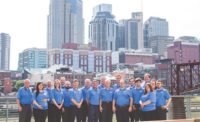
In the beginning, it was supposed to be a simple solar thermal installation. TheUniversity of Arizonawas looking for a renewable energy source to heat its student recreation center pool.
“Large-scale solar pool heating does not have the best financials associated with it,” Tempe-basedGreenfield DynamicsengineerMichael Suyehirasays.
Suyehira and Greenfield Dynamics, a supplier of integrated solar and hydronic equipment for commercial buildings throughout the Southwest, collaborated with Tempe-basedAmerescoand Phoenix-basedW.J. Maloney Plumbingto come up with an even better solution.
“The idea of using air conditioning as well as heating the pool off the same field is what makes the system unique, and worth the time and money put into it,” W.J. Maloney Plumbing Project ManagerTravis Brockstates.
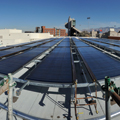
“I have never seen a system like this,” Suyehira says. “Typically, you use a cooling tower on the condenser side and reject the heat. Here, we are utilizing the waste heat to heat the pool.”
The pool component is part of a grander-scale energy-savings program at the university. A large chunk of the overall project involves the use of photovoltaic solar.
Suyehira and Greenfield were involved in other aspects of the overall campus project, including the installation of a small pool-heating system at the university’s competitive dive pool, where 48 4-foot by 10-foot glazed flat-plate collectors are installed. Aurora pumps move a 25% water-glycol solution through the collectors and then through an Aurora titanium plate-and-frame heat exchanger. To transfer the heat, water is drawn off the high-pressure side of the pool line and flowed through the heat exchanger to the low-pressure side. Expansion tanks are used on the closed-loop side.
“That project was strictly pool heating,” Suyehira states.
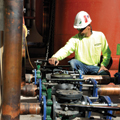
Best of Both Worlds
For the student recreation pool, a series of Sunda Seido 2 direct-flow evacuated tube solar panels heat the water. The heated water pumps through a 10,000-gallon insulated and jacketed storage tank, which feeds the absorption chiller. Once the water in the storage tank reaches 205°F, the chiller turns on and runs until the storage tank water drops to 165° F.“It runs every day we have heat and the pool requires heat,” Suyehira says.
The system’s Aurora pumps run off ABB variable-frequency drives. The loop has a 25% water-glycol mixture for freeze protection.
“We tie into the return side of the campus chilled-water loop before it goes back to their chillers,” Suyehira states. “It’s a 150-ton Broad absorption chiller. On the condenser side, we pump through a titanium plate-and-frame heat exchanger to transfer heat from the condenser loop into the pool.”
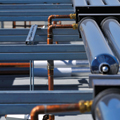
“One of the unique things about these panels is that it is a direct flow system, so they don’t stand or have the traditional angle a typical solar panel would have,” Brock explains. “The manifolds are lined north to south, allowing the evacuated tubes to lie parallel to the roof. Each individual tube is adjusted to its optimum angle toward the sun. We used more than 5,500 evacuated glass tubes and pumped through them. It made for a little logistical challenge.”
Pipe also played a key role in the installation. More than 3,500 feet of Cerro copper pipe (diameters from 2 inches to 5 inches) was used.
“The runs on the roof were each near 200 feet in length,” Brock notes. “Each row of panels has a feed and return line underneath it, branching to connect with the panel banks. As the system heats during the day and then cools at night, it presented some extreme expansion and contraction problems. We used Metraflex compensators to allow for that. As quickly as that system can heat up, we needed some flexibility.”
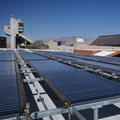
“We were able to install an absorption chiller that generates chilled water for the campus as well as the heat exchanger in the condenser loop instead of using the standard cooling tower,” Suyehira says. “From the same solar field we get chilled water and pool heating.
“The university already was running the chilled loop year-round and we had been looking at doing a solar-fired absorption chiller on some other projects. We came to the conclusion that we could use the pool as the condenser. It made the whole system work.”
If the pool does not require heat, the solar thermal system does not run.
“The primary purpose here is pool heating,” Suyehira states. “The amount we are providing to the chilled loop is small compared to the cooling capacity of the university. The controls are driven off the pool temperature, so if the pool does not require heat, then we don’t run the system. There is no other way to dissipate the heat from the condenser loop.”
Turnbull fan-coil units on the solar loop are used for overheating protection.
“If we are not running the system and we are still generating heat, we bypass water through the fan-coil units to reject the heat,” he says.
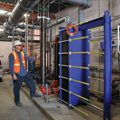
Big Bang For the Buck
Several different energy-efficient components are part of the project - one of which is the body of water in the student recreation center. “That pool was sitting right there,” Suyehira states. “Instead of rejecting the heat, we could actually utilize it.”Suyehira has seen components of this concept used in other installations, but none where the solar is tied to both heating and cooling.
“In the past, there have been some solar-fired absorption chillers, but they were only used in chilling applications,” he says. “This type of chiller typically operates at a .76 COP (coefficient of performance). That’s not very good compared to compressor-based chillers. With this system, we are driving the absorption chiller with solar heat to produce chilled water and then using the waste heat in the pool. I have never seen a system that utilizes the waste heat.”
Because it’s part of a bigger project equation, exact cost and energy savings are hard to pinpoint, but greater efficiencies will be realized.
“You get a multiplier effect because you’re taking the solar energy from the one solar field and you’re getting both chilled water plus the pool heating,” Suyehira says. “It’s a two-for-one deal. This is a system that will operate for a long time.”
Brock feels the timing is perfect for more commercial buildings to invest in solar thermal technologies. “It’s available for anybody right now,” he says.
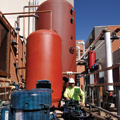
“Rebates are available from a variety of sources - the federal government, the state of Arizona, as well as other programs,” he explains. “With the amount of rebates you can get on so many different levels, it makes it encouraging for people to investigate solar energy like this.”
The University of Arizona now has a solar thermal system that will produce energy and cost savings around the clock.
“The great thing about this system is it maintains its ability to be productive throughout the year,” Brock notes. “During the winter months, as it gets cooler, the pool will require more heat, but because of the warm climate in Tucson, the chilled-water loop may be needed year-round. If air conditioning is needed, the system can continue to contribute on that level, even in winter months. Certainly, there will be months it can be more productive than others, but you should never have to shut it down for any particular season. It’s a nice year-round system.”

